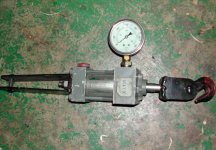SPYDERLK
Super Star Member
- Joined
- Feb 28, 2006
- Messages
- 10,160
- Location
- VA
- Tractor
- JD2010, Kubota3450,2550, Mahindra 7520 w FEL w Skid Steer QC w/Tilt Tatch, & BH, BX1500
I was curious about this because my experience at gut level indicated a much less pronounced effect on my ML275 loader. Im dealing with some stumps right now so I had good opportunity to test it yesterday.
I managed to get a ~ 1T stump in my bucket and raised it from ground to full height. 1100psi was good for a few feet, and then I had to use escalating pressure up to 1400psi to attain the 11' max height.On the surface this indicates an 11/14 force maintenance in contrast to ~1/2 in the graphs.In conjunction with this real world scenario it has to be noted that the load point relative to the pins had to be changed a bit with height to prevent the stump from tipping back out of the bucket and killing me. This rotation uncurl of the bucket and rotation upward of the arms factor to change the lift point a littleI think not a significant factor, but of course the best test would be to suspend the load or use a force gauge on a vertical tensile line. One loses test range and the other requires a nice force gauge and a good anchor point.
LD1, I would be interested in what your loader shows in a similar real world test. I know youll counterweight and be careful to watch bucket orientation while multitasking. Thats what makes it especially dangerous - the extra task. Im used to raising stumps to full height and dropping them to dislodge dirt. Watching a gauge concurrently is a distraction that is and should be scary.A set of forks with a log on would be ideal.
Different loader. But I assume you have a gauge tee'd into the lift circuit similar to how I had the one on my old L3400?
Because if this is the case, you are overlooking a very critical part of the calculation....
The pressure required to lift the dead weight of the loader itself.
On my old L3400, it was 600psi just to carry the arms and empty bucket.
So in your scenerio....if a similar 600psi is just the dead weight of the loader.....taking that out.....it took you ~500psi to lift the stump down low, and 800psi to full height.
5/8ths is a lot closer to what a typical graph indicates as opposed to the 11/14ths you observed on the surface of things.
Ah-h. Good catch!
I saw your reply last evening and waited 'til today so I could go out and experimentally establish the offset range
Were going to have to suspend disbelief on this for a little bit -- but mine lifts off at 250psi and tops out at 325. ... Repeated 3 times.
Note the extreme similarity between 250/325 and 11/14!! Note also that this is a 5000PSI gauge so 250 - 325 is just off the peg. No trust there. Also this gauge has been in the pump output circuit for years and lost its glycerine fill about a year ago.
Since then Ive noticed lower indicated free flow pressures [vs RPM] in the hyd circuit.
So the "trust" range is all over the place on this gauge. I will redo the test using an identical new 2000PSI gauge that I have and report back. It may not be soon. Have to get a replacement for the original and wait for a play day.

